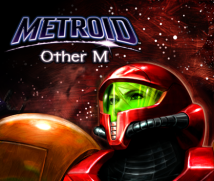Page 5
And finally, I’ll talk about my latest project, “METROID: Other M.”
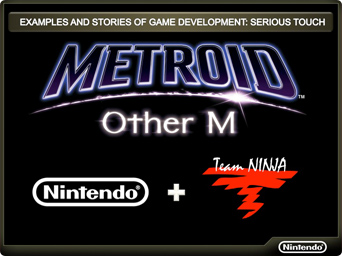
I think this title is the synthesis of all the know-how I’ve acquired and the culmination of all the images I’ve been envisioning in a “serious touch” title. I acted as Producer, but I think my participation has been different from a normal producer’s role. On this project, I wrote a story that takes place between “SUPER METROID” and “METROID Fusion.” It also reintroduces Adam Malkovich, who had appeared in Fusion in a certain form. I tell the story of Samus as a young girl and reveal her relationship with Adam, but that’s just a portion of Other M. Using the know-how I gained while working on “Famicom Detective Club,” I tried to give the game an overall suspenseful feel. Human drama is another element of the METROID series, so I decided to explore the story of Samus and Adam from that perspective. When creating the scenario for the game, I realised it was possible to closely control the “mood,” “timing,” “foreshadowing,” and “contrast” even when just sketching a scenario. I believe I was able to use my past experience writing game scenarios to the fullest here, creating a storyline that gave the Samus character the opportunity to indulge in some beautifully-acted sequences. I also created another element that was key to the telling of the story, the outline of the game design. I laid the foundation, you could say. The next step was to find the ultimate partner to collaborate on this project with. That was where Team NINJA29 came in.
29 Team NINJA is a development team within TECMO. Titles they have developed include the Dead or Alive and Ninja Gaiden action game series.
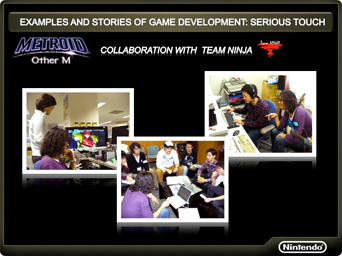
his was the start of an ideal - and stimulating - collaboration between Team NINJA and Nintendo. To see the model of Samus’s features, the faces of the characters, to experience the motions, the visual design, the effects, the level designs, and the sounds is to understand just how talented this group is with Mr. Yousei Hayashi30 at the helm. And this team and those of us on the Nintendo Metroid team were on the same wavelength.
30 Yosuke Hayashi is the director on METROID: Other M. He is the leader of TECMO KOEI’s Team Ninja. He appeared in Iwata Asks: METROID: Other M: The Collaboration.
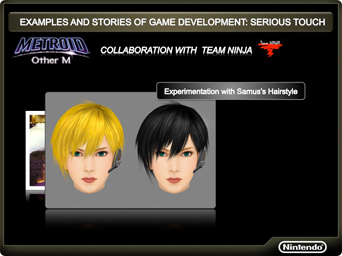
We had the same concerns and were able to agree on many things and bounce ideas honestly off one another, despite the boundaries of company affiliation. The culmination of the close collaboration between the Nintendo staff and Team NINJA staff and our diligence laid the way for the creation of this new type of Metroid. With the goal of making Other M the ultimate Metroid game, we worked as equals without limitations. Let me share a definitive moment about developing the control scheme on Other M.
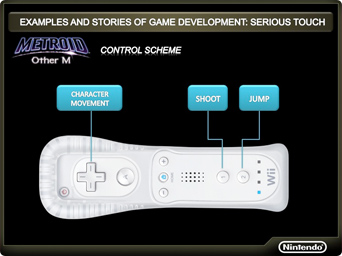
When planning this game, there was one thing that I was unwilling to budge on. That was making it possible to control Samus using just the Wii Remote. With a jump-action shooting game like Metroid, controls beyond moving with the +Control Pad and jumping and shooting with two buttons is unthinkable. For this reason, in the beginning, I thought Samus should move along a path. Yes, Samus would move along an invisible rail. As long as the camera angle was controlled effectively, I believed it would be possible to give the game an impressive look. As soon as the collaboration began, however, Team NINJA suggested the use of the Nunchuk. I firmly objected and explained to them why I wanted controls using just the Wii Remote. They understood my reasoning immediately. And even beyond that, they proposed a system with a full 3D map where Samus could move freely using the Control Pad. I had no objections if that was indeed possible. But I was dubious. I thought - if it was really so simple, why hadn’t anyone done it before? But Mr. Hayashi had many prior successes, and of course I had confidence in him.
And then the day came when we tried this control method. It was perfect. It was smooth. In addition, Samus’s quick actions and perpendicular positioning worked ideally with the basic Metroid map. In this way, the ideal basic system incorporating 2D-like nimble movement using a horizontal Wii Remote and pointer-based FPS gameplay was born. Mr. Hayashi called this style the “NES game with the latest technology.” I think that fit perfectly. Also, for the Other M game design it was necessary to make the transition from gameplay to cinematics seamless and stylish. And “mood,” “timing,” “foreshadowing,” and “contrast” were necessary here as well. In order to convey this accurately, I used something called a ”movie spec sheet.” For the game capture and motion capture materials I created a moving spec sheet. Of course, sound and sound effects were also included. The video editing skills I learned in hopes of editing my son’s video clips came in handy.
And I’d like to also introduce another group of talented people who joined us on the project.
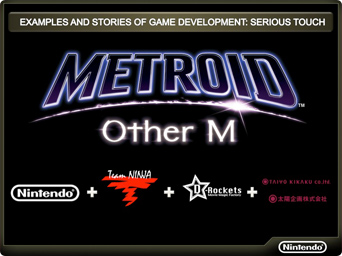
CG experts D-Rockets31, led by director Mr. Ryuji Kitaura32 and movie-production company Taiyo Kikaku33, two companies that had previously-established relationships with Team NINJA, joined the effort. 31 D-Rockets co., ltd. is a creative unit that produces cinematic content such as CG for commercials, video games, promotional videos and so on. They were established in 2008. 32 Ryuzi Kitaura is the Executive Director on METROID: Other M, representing D-Rockets, a CG production company. He appeared in Iwata Asks - Metroid: Other M 33 Taiyo Kikaku co. ltd. is a cinematic production company with headquarters in Tokyo. They perform design and production in a range of genres, from TV commercials to web content, exhibition cinematics and CG. For details, please refer to Iwata Asks - Metroid: Other M
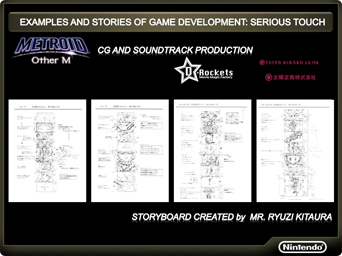
When I saw the storyboard that Director Kitaura had created, I was speechless. Because what he had created so far exceeded what I had conveyed to him; my imagination couldn’t keep up. Was it really possible to create those images? Thoughts swirled around my head and seeing me speechless, apparently got Director Kitaura thinking, “Maybe he doesn’t like it…” But the contents of that storyboard became the Other M opening movie.
In this way, the world created by Director Kitaura easily exceeded even my own expectations and gave life to the Metroid world, made Samus Aran a beautiful heroine, and imparted the action scenes with the intensity they required.
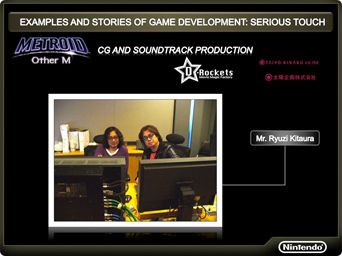
Director Kitaura is one year older than I am. We were born at roughly the same time and grew up as part of the same generation. We have similar roots and influences. But there are also many different things mixed in. I have a lot of fun comparing notes about what kind of materials we have hidden away in our mental archives. This compilation of life experiences has helped make Other M that much more beautiful and cool – I don’t think I could be any happier about how it’s turned out.
This director’s creative vision is produced by Taiyo Kikaku and is supported by the top CG artists in Japan. This strong bond between companies is what makes for this combination.
And in addition, Director Kitaura’s good friend and renowned artist Mr. Kuniaki Haishima34…
34 Kuniaki Haishima is a composer who is active in a wide range of genres, including films, TV dramas, anime, video games, and TV commercials.
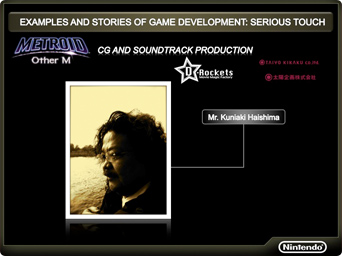
...also produced the music for us. And the music they created also exceeded my expectations. I am very peculiar about the synchronisation of image and music and the team was able to support it perfectly for Other M with their collaborative strength. When I first saw the movie with Mr. Haishima’s music applied, I was surprised that it felt so complete. But Mr. Kitaura’s words as he watched it with me, surprised me even more. “This is apparently still in the sketching phase35.” He said. The fully orchestrated music that synchs up perfectly with Director Kitaura’s visuals will be moving your hearts very soon.
35 If a piece of music is in the ‘Sketching phase’, it has been produced or completed to a stage where its melodies, harmonies and general trends can, to an extent, be understood.
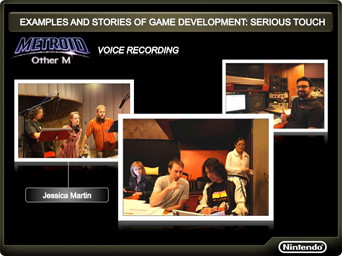
And the words that I’m so particular about finally became voices. Expert voice actors lent their voices to bring life to my characters. For this reason, we were very selective when casting the voice actors. We chose them all without compromise. Though there were some who were a challenge to sign on, we worked with them in sealing the deal. When choosing the voice of Samus, a character with a lot of monologues, there was one actress in particular who made us think, “It has to be her!” and that actor was Jessica Martin. The voice of Samus needs to sound ephemeral, as if she speaks from the heart - and Jessica’s voice matched the Metroid world perfectly.
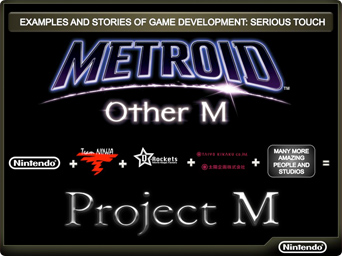
And there are still other amazing people and studios involved with this project. Unfortunately, it’s not possible for me to mention all of them here. We call ourselves “Project M.” Regardless of company name or field of expertise, the way we all came together with the common goal of creating the ideal production is identical to the way a band might form. And imagining Other M as a tune in which each player plays his individual part, producing a harmony or a groove, gives the most accurate impression of the way things transpired. And we continue to devote ourselves to the goal of delivering the newest, most beautiful METROID to you. Please be patient for a little longer.
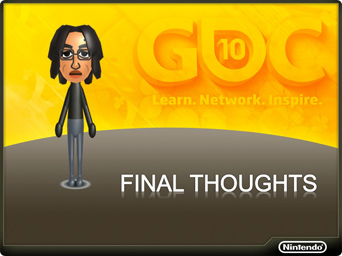
Our time together has almost come to an end. There is still a lot that I’d like to talk to you about. In closing, I’d like to talk to you about some things that I always keep in mind with every game I am developing.
I think developing games is all about giving shape to images. Throughout the course of my life, I have come across many things. Things from movies or music – things created by people – human beings, objects, living creatures, etc. My spirit has been moved by my interactions – such as when I saw something beautiful, or amazing, or when I experienced happiness or joy, fear or sadness. I think these experiences create individual images that stick with us. From the perspective of someone who makes games, I believe that it’s our job to take those moments when our spirits have been moved and represent them with understandable forms – in other words, it’s our mission to give our images shapes that can be conveyed to other people.

When I sat down for the first time as an employee of Nintendo, the Famicom had not been released yet. After that, through a course of events, I was tasked with developing video games and began doing so by finding my own way. I don’t know if it just really suited my personality, but I’ve since been very passionate about what I do. I think it’s similar to the way a child who is given a new toy becomes engrossed with it. I remember that feeling when working on the first METROID. A few years later, I received a small package. In that package… were a letter and some handmade chocolates. In that simple letter, a woman wrote that she enjoyed the game that we had developed so much that she decided to make and send us some Valentine’s Day chocolates. In Japan there is a tradition where women make chocolates to give to the men that they are romantically interested in. At that moment, I felt as though I had just woken up. Even more than moving me emotionally, it came as a bit of a shock. What we create touches the hearts and spirits of people and can move them – as embarrassing as it is, that was the first time I’d realised that simple fact. It was the first time I’d discovered the feeling of responsibility as a professional. This was the impetus to make me imagine the faces of the people playing while I create a game. I’d imagine the faces of my wife, my friends, and even complete strangers. Lately, I’ve found myself imagining the face of my son more and more. I find myself wanting to make a game that brings out the best possible reaction on the faces of my imagined audience.
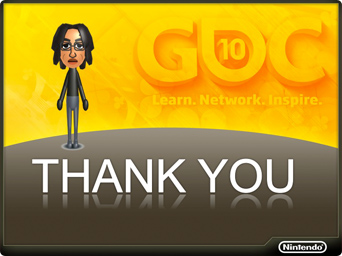
I think most of you gathered here are in some way or another involved in game development. I hope that you will continue to convey the beautiful and fun things stored in your hearts to the players that love games. I believe that if we all do so, we can create games that last forever. This ends my presentation. Thank you for listening. I look forward to seeing you again.
